Options and Strategies for Planning Water and Climate Security in the Occupied Palestinian Territories
Abstract
:1. Introduction
Concepts and Context
- Extreme temperature changes, limited groundwater and rainfall, and little arable and cultivable land have made this region a climate hotspot rendering it one of the world’s most susceptible landscapes to climate change [3];
- The states in the region have 6% of the world’s population but less than 1% of the world’s freshwater resources, making them water-insecure from a hydrological perspective [22];
- The complexity in water sharing arrangements is inevitable as transboundary water management and cooperation remain a difficult issue in this region, particularly among the three riparian states of the Jordan Basin (Jordan, Israel, and OPT), wherein the regional political situation and geopolitical conflicts have significantly influenced the sharing arrangements to function efficiently [21];
- Water conflicts are of common occurrence, and the water allocation and distribution mechanisms in this basin are discussed at various regional negotiations and positioned as an important component of the Palestinian-Israeli conflict [23];
- Water scarcity in Israel and the OPT region has been the subject of much discussion in academics, politics, and the public sphere, both locally and globally [24];
- Geopolitical tensions pose restrictions on regional water security; for instance, the Israeli-Palestinian conflict is typically presented as a confrontation of equals over a piece of land or access to a resource [22]. The pertinence of this is that the Oslo II water regime unevenly applies to only part of one of the three resources to which Israel and the Palestinians are co-riparians. The utilization of all three resources is highly asymmetrical in Israel’s favor [25];
- Narratives of water-sharing disharmony in this region are multifaceted; for example, Freij [20] argues that for decades. The day-to-day daily struggles to build stability in the settings of the Palestinian-Israeli conflict, and resulting impacts like displacement, have shadowed attention on sustainability challenges. Moreover, regional water discussions are often dominated by discussions on conflict and challenging circumstances it presents for cooperation towards water management and adaptation strategies [26];
- Disputes over water distribution from shared aquifers and the Jordan River highlight that cross-border water sharing and collaboration is an unresolved dimension in the regional water governance disclosures [27].
- (a)
- What are the key challenges to water security in the region and for OPT?
- (b)
- How does climate change affect water availability and security in the MENA region and OPT?
- (c)
- What are the barriers and opportunities to water security given the hydro-political conflicts and climate change crises faced by the region and OPT territories?
2. Materials and Methods
3. Results
3.1. Multiscalar Analysis for Assessing Water Security
- (a)
- Regional Assessment for the MENA region
- (b)
- Subregional or basin-scale assessment (Jordan, Israel, and OPT)
- (c)
- National-scale assessment
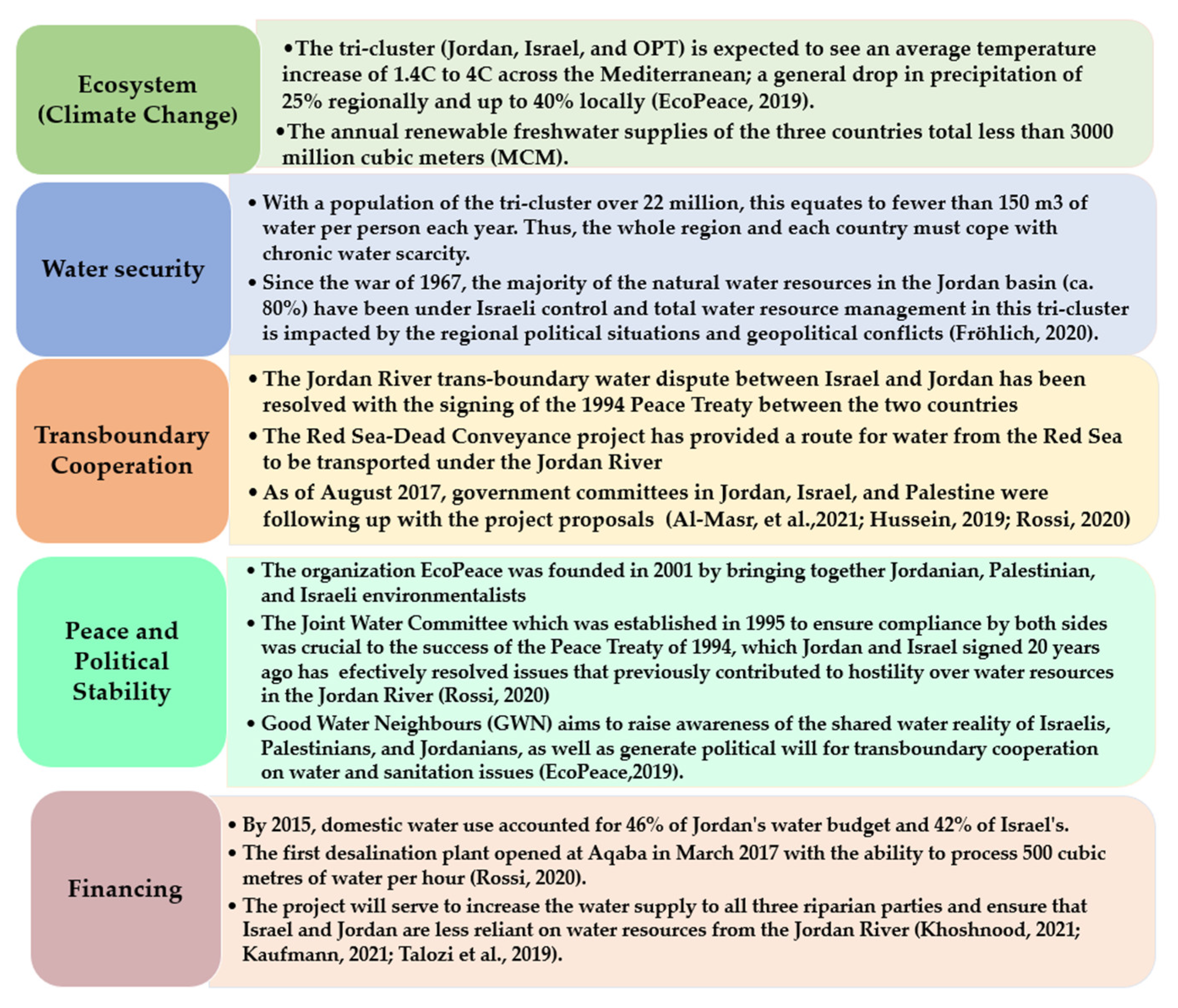
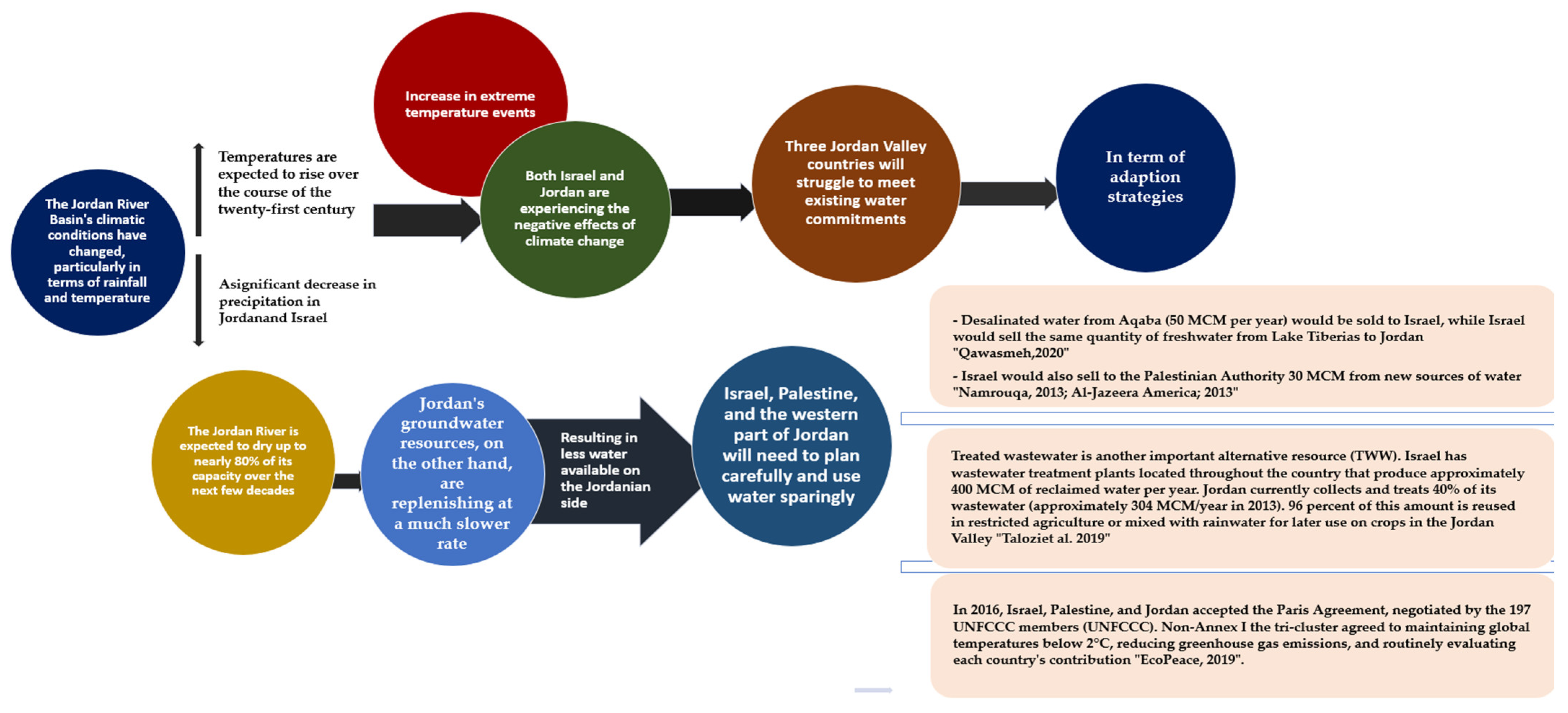
“To secure water resources and achieve their continuous flow in arid and semi-arid areas of the globe is a highly challenging task because one is dealing with the “management of scarcity” threatened by droughts, climate changes, population growth, water quality deterioration, transboundary water bodies, and social and political detriments” [79].
3.2. Gaps and Needs for Building Water Security and Climate Resilience
- Integration of plans and policies to manage water crisis and climate change impacts at national and regional levels. In this region, states and communities are severely impacted by multifaceted climate change and will unavoidably have to adapt [20]. Adaptation challenges in the OPT involve a spectrum of reactions and particularly managing the diverse impacts of extreme weather events through a multi-stakeholder partnership between governmental, civil society, and commercial sector players [82]. Climate change adaptation often focuses on the national level, on aspects such as internal relocation, and internal displacement as adaptation strategies. However, these options are also limited by political volatility such as the Israeli–Palestinian conflict and the lack of consensus in managing transboundary water, [61]. International agencies like UNDP focus on efforts (projects and interventions) to build a climate change adaptation strategy and action plan with the input and participation of stakeholders [56]. While it is widely acknowledged that integrated agendas to manage water crisis and climate change impacts have the potential to open up new avenues for cross-border (Israeli-Palestinian) collaboration, much is left to explore the full opportunities for collaboration and consent.
- Adaptation options and solutions to reflect (and address) water-related conflicts. The region reports on multiple and diverse levels of conflict, including water-related conflicts. Communities and people in the cross-border region are often exposed to military interventions and forced to examine alternative water supply methods, including the use of wastewater for agricultural irrigation and saltwater desalination from the Mediterranean Sea. Some of these alternative methods allow the Gaza Strip’s Palestinian people to have a freshwater supply for their household needs [49]. Critics comment that desalination as an option to fulfill water demand could jeopardize Palestine to negotiate their legitimate water rights in shared water (as discussed: surface water from the Jordan River on the eastern border of historic Palestine and Jordan, and the Tiberias Lake; groundwater from the MAS and its three basins beneath the occupied West Bank and groundwater from the aquifer) systems [24]. There is a constant conflict situation linked to these settings. While it is difficult to envision how considerable improvements in the Gaza Strip’s water supply can occur without massive investment in desalination, and international cooperation [81]. For example, the EU and UNICEF, in collaboration with the PWA and Gaza’s Coastal Municipalities Water Utilities launched a proposal to develop a desalination plant in the Gaza Strip by 2020 [85]. With support from the Kuwaiti Fund via the Islamic Development Bank, the Palestinian Water Authority constructed the first seawater desalination plant in the Gaza Strip in 2019, located in Gaza City and, with a 10,000 cubic meters daily capacity to service about 200,000 people (i.e., 10% of the OPT population in Gaza strip) [46]. In March 2018, a financial commitment of about EURO456 million to the Gaza Central Desalination Plant and Associated Works Project committed to producing 55 MCM of water supply all year long, with energy supply from solar facilities [40,86]. In the context of leveraging alternative means for adaptation, [46] commented that enhanced solar capacity could thrive in Gaza and help fill the energy demand; however, land rights are a barrier. In Gaza, three desalination plants supported by the international community produced approximately 13 million cubic meters of water annually. It is also acknowledged that the process requires significant amounts of electricity and fuel; as a result, acute power shortages and restrictions on material imports limit their ability to operate at full capacity or to ensure adequate and continuous access to water which remains a critical challenge [47]. Israel’s control, particularly in Area C, significantly restricts the spectrum of activities that Palestinian policymakers may independently undertake toward the sense of water security for citizens and communities. The permission of the Israeli Civil Administration is required for the bulk of water and energy infrastructure projects in the West Bank [87].
- Multilevel strategies for planning water and climate security. The water and climate security agenda must be evaluated within a political-economic framework, and solutions challenges for specific challenges in a region or community are appropriately assessed and addressed [20], it is widely acknowledged that governance challenges operate at the local scale. For instance, in the OPT lack of capacity of national agencies and local governments to develop effective adaptation and DRM plans; or lack of mechanisms to enable suitable planning and implementation, or it can be limited information on technological options to address the challenges [76]. Overall, the political environment affects the authorities and institutions’ capacity to actively respond to emerging water crisis or insecurity scenarios or to deploy context-specific water and climate security strategies [26]. In this context, the UNDP lead strategy identified adaptation options for the OPT and recommended ‘no-regrets’ and ‘low-regrets’ adaptation measures that position water as the priority focus in managing climate change impacts should be attended to on a priority basis. Further, noting that the Jordan Valley and the Gaza Strip experience a high level of climate vulnerability, in tandem with increasing water and food insecurity concerns, this strategy should acknowledge agriculture as the most sensitive sector of the Palestinian economy, and in the face of future climate risks the ‘need for climate modeling and research capacity-building in the OPT’ is tailored to local and subnational adaptation priorities [62,78,88]. It is crucial to note that at the national level commitments, both Israel and Palestine have international law obligations which include their commitments under the Paris Agreement on Climate Change 2016 and the United Nations Framework Convention on Climate Change (UNFCCC) adopted by both parties [24,40,41] in which, Palestine upgraded its status (17 March 2016) from “Observer” to “Party” to the UNFCC to becoming its full member [89].
3.3. Key Discussion Points
3.4. Concluding Notes
Author Contributions
Funding
Institutional Review Board Statement
Informed Consent Statement
Data Availability Statement
Acknowledgments
Conflicts of Interest
References
- IPCC. Summary for Policymakers. In Climate Change 2021: The Physical Science Basis. Contribution of Working Group I to the Sixth Assessment Report of the Intergovernmental Panel on Climate Change; Masson-Delmotte, V., Zhai, P., Pirani, A., Connors, S.L., Péan, C., Berger, S., Caud, N., Chen, Y., Goldfarb, L., Gomis, M.I., et al., Eds.; IPCC: Geneva, Switzerland, 2021; Available online: https://www.ipcc.ch/report/ar6/wg1/downloads/report/IPCC_AR6_WGI_SPM_final.pdf (accessed on 14 February 2022).
- Chaturvedi, A.; Pandey, B.; Yadav, A.K.; Saroj, S. An overview of the potential impacts of global climate change on water resources. Water Conserv. Era Glob. Clim. Chang. 2021, 99–120. Available online: https://www.sciencedirect.com/science/article/pii/B9780128202005000129 (accessed on 14 February 2022).
- Lang, M.A. Impacts of climate change on the Eastern Mediterranean and the Middle East and North Africa region and the water-energy nexus. Atmosphere 2019, 10, 455. Available online: https://www.mdpi.com/2073-4433/10/8/455 (accessed on 12 February 2022). [CrossRef] [Green Version]
- UN-Water. Summary Progress Update 2021–SDG 6– water and sanitation for all. Version: July 2021.Geneva, Switzerland. Available online: https://www.unwater.org/publications/summary-progress-update-2021-sdg-6-water-and-sanitation-for-all/ (accessed on 27 January 2022).
- Cramer, W.; Guiot, J.; Fader, M.; Garrabou, J.; Gattuso, J.P.; Iglesias, A.; Lange, M.A.; Lionello, P.; Llasat, M.C.; Paz, S.; et al. Climate change and interconnected risks to sustainable development in the Mediterranean. Nat. Clim. Chang. 2018, 8, 972–980. [Google Scholar] [CrossRef] [Green Version]
- United Nations Environment Programme (UNEP). “Climate Change—Introduction”. Available online: https://na.unep.net/geas/climate-change.php (accessed on 3 March 2022).
- Borghesi, S.; Ticci, E. Climate Change in the MENA Region: Environmental Risks, Socioeconomic Effects and Policy Challenges for the Future. IEMed Mediterr 2019, 2019, 289–292. Available online: https://usiena-air.unisi.it/retrieve/handle/11365/1121314/327344/MENA_Borghesi_Ticci2019.pdf (accessed on 27 February 2022).
- Naugle, A.B.; Backus, G.A.; Tidwell, V.C.; Kistin-Keller, E.; Villa, D.L. A regional model of climate change and human migration. In Research Anthology on Environmental and Societal Impacts of Climate Change; IGI Global: Hershey, PA, USA, 2022; pp. 449–471. (accessed on 21 February 2022). [Google Scholar] [CrossRef]
- Nevitt, M.P. On Environmental Law, Climate Change, & National Security Law. Harv. Envtl. Law Rev. 2020, 44, 321. Available online: https://heinonline.org/HOL/LandingPage?handle=hein.journals/helr44&div=12&id=&page= (accessed on 24 January 2022).
- Hohenthal, J.; Minoia, P. Social Aspects of Water Scarcity and Drought. In Handbook of Drought and Water Scarcity; CRC Press Taylor & Francis LTD: Boca Raton, FL, USA, 2017; pp. 607–625. [Google Scholar] [CrossRef]
- Abukhater, A. Palestine-Peace by Piece: Transformative Conflict Resolution for Land and Transboundary Water Resources; Springer: 2019. Available online: https://link.springer.com/chapter/10.1007/978-3-030-03985-1_4 (accessed on 7 February 2022).
- Al-Masri, R.A.; Spyridopoulos, T.; Karatzas, S.; Lazari, V.; Tryfonas, T. A Systems Approach to Understanding Geopolitical Tensions in the Middle East in the Face of a Global Water Shortage. Int. J. Syst. Dyn. Appl. (IJSDA) 2021, 10, 1–23. Available online: https://www.igi-global.com/article/a-systems-approach-to-understanding-geopolitical-tensions-in-the-middle-east-in-the-face-of-a-global-water-shortage/289431 (accessed on 6 February 2022). [CrossRef]
- Neupane, J.L. Dynamics of Hydro-power Development in Nepal: Water-Energy-Food Security Prospect. 2022. Available online: https://www.diva-portal.org/smash/record.jsf?dswid=-4612&pid=diva2%3A1665598 (accessed on 9 April 2022).
- Cook, C.; Bakker, K. Water security: Debating an emerging paradigm. Glob. Environ. Chang. 2012, 22, 94–102. Available online: https://www.sciencedirect.com/science/article/abs/pii/S0959378011001804 (accessed on 27 January 2022). [CrossRef]
- Un-Water Water Security Agenda; United Nations University Institute for Water, Environment & Health (UNU-INWEH/ Hamilton, Ontario L8P 0A1 Canada). 2013. Available online: https://collections.unu.edu/eserv/UNU:2651/Water-Security-and-the-Global-Water-Agenda.pdf (accessed on 27 October 2021). ISBN 978928086038.
- Giordano, G. Water as a Source of Regional Cooperation in the Middle East: The Work of EcoPeace Middle East in Jordan, Israel, and Palestine. Open Rivers J. 2018, 11. Available online: https://editions.lib.umn.edu/openrivers/article/the-work-of-ecopeace-middle-east/ (accessed on 14 January 2022).
- EcoPeace. Middle East. Climate Change, Water Security, and National Security for Jordan, Palestine, and Israel, Amman, Jordan; Tel Aviv, Israel; Ramallah, Palestine; Carry, I., Ed. (Berlin, Germany). 2019. Available online: https://hidropolitikakademi.org/uploads/wp/2019/07/climate-change-web.pdf (accessed on 15 October 2021).
- UNCCS. Opportunities and Options for Integrating Climate Change Adaptation with the Sustainable Development Goals and the Sendai Framework for Disaster Risk Reduction 2015–2030. United Nations Climate Change Secretariat. 2017. Available online: https://unfccc.int/sites/default/files/resource/techpaper_adaptation.pdf (accessed on 16 March 2022).
- Hussein, H.; Menga, F.; Greco, F. Monitoring transboundary water cooperation in SDG 6.5. 2: How a critical hydropolitics approach can spot inequitable outcomes. Sustainability 2018, 10, 3640. Available online: https://www.mdpi.com/2071-1050/10/10/3640 (accessed on 22 January 2022). [CrossRef] [Green Version]
- Freij, L. Climate Change and the Vulnerable Occupied Palestinian Territories. UCLA J. Envtl. Law Policy 2021, 39, 65. Available online: https://web.archive.org/web/20210518024937id_/https://escholarship.org/content/qt5tf728m4/qt5tf728m4.pdf?t=qq7quq (accessed on 12 October 2021). [CrossRef]
- Noureddine, G.; Eslamian, S.; Katlane, R. Water, Climate Change and Agriculture in MENA regions (the Middle East and North Africa). Water Sciences and Environment Technologies; 2021; pp. 66–87. Available online: http://jistee.org/wp-content/uploads/2021/06/JISTEEv6N2-Juin2021.pdf#page=67 (accessed on 26 January 2022).
- Fröhlich, C. Desecuritisation of Water as a Key for Water Diplomacy. European Institute of the Mediterranean (IEMed). 2020. Available online: https://www.euromesco.net/publication/ensuring-water-security-in-the-middle-east-policy-implications (accessed on 22 February 2022).
- Scott, K. Can the Middle East Solve Its Water Problem? 2019. Available online: https://www.cnn.com/2018/07/11/middleeast/middle-east-water/index.html (accessed on 14 February 2022).
- Dai, L. Implementation Constraints on Israel–PalestineWater Cooperation: An Analysis Using the Water Governance Assessment Framework. Water 2021, 13, 620. [Google Scholar] [CrossRef]
- Selby, J. Cooperation, domination and colonisation: The Israeli-Palestinian joint water committee. Water Altern. 2013, 6, 1. Available online: https://www.cabdirect.org/cabdirect/abstract/20133123939 (accessed on 4 October 2022).
- Schillinger, J. Adapting to Water Scarcity in the Israeli-Palestinian Conflict: An Analysis of the Influence of Conflict on Water Governance and the Implementation of Adaptation Strategies. Master’s Thesis, International Land and Water Management Chair group Earth System Sciences (ESS)/ Natherlands. 2016. Available online: https://edepot.wur.nl/424633 (accessed on 3 March 2022).
- Kaufmann, W. Good Water Neighbours: Direct and Indirect Effects of Community Engagement on Transboundary Water Cooperation in the Jordan River Basin. 2021. Available online: https://www.diva-portal.org/smash/record.jsf?pid=diva2%3A1562542&dswid=4475 (accessed on 27 January 2022).
- Palestinian Central Bureau of Statistics (PCBS). Palestinian Central Bureau of Statistics (PCBS) Presents the Conditions of Palestinian Populations on the Occasion of the International Population Day, 11 July 2022. 2022. Available online: https://pcbs.gov.ps/post.aspx?lang=en&ItemID=4279 (accessed on 14 August 2022).
- Lossow, T.; Shatat, M. Less, and Less: Water in the Middle East. IEMed. 2020. Available online: https://www.euneighbours.eu/sites/default/files/publications/2020-04/JPS-15-Water-Security-in-the-Middle-East.pdf#page=33 (accessed on 14 March 2022).
- Loudyi, D.; Kantoush, S.A. Flood risk management in the Middle East and North Africa (MENA) region. Urban Water J. 2020, 17, 379–380. Available online: https://www.tandfonline.com/doi/full/10.1080/1573062X.2020.1777754 (accessed on 12 March 2022). [CrossRef]
- Solomon, H.; Tausch, A. Overcoming the Environmental Challenge in the MENA Region. In Arab MENA Countries: Vulnerabilities and Constraints Against Democracy on the Eve of the Global COVID-19 Crisis; Springer: Singapore, 2021; pp. 233–244. Available online: https://link.springer.com/chapter/10.1007/978-981-15-7047-6_8 (accessed on 22 February 2022).
- Scheffran, J. The Geopolitical Impact of Climate Change in the Mediterranean Region: Climate Change as a Trigger of Conflict and Migration. Mediterranean Yearbook. 2020. Available online: https://www.iemed.org/wp-content/uploads/2021/01/The-Geopolitical-Impact-of-Climate-Change-in-the-Mediterranean-Region-Climate-Change-as-a-Trigger-of-Conflict-and-Migration.pdf (accessed on 27 February 2022).
- Bozorg-Haddad, O.; Zolghadr-Asli, B.; Sarzaeim, P.; Aboutalebi, M.; Chu, X.; Loáiciga, H.A. Evaluation of water shortage crisis in the Middle East and possible remedies. J. Water Supply Res. Technol.-AQUA 2020, 69, 85–98. Available online: https://drive.google.com/file/d/13t_4GHxLuzl7S-bgR9x3CEtYd4_5v2p1/view (accessed on 3 March 2022). [CrossRef]
- Waha, K.; Krummenauer, L.; Adams, S.; Aich, V.; Baarsch, F.; Coumou, D.; Fader, M.; Hoff, H.; Jobbins, G.; Marcus, R.; et al. Climate change impacts in the Middle East and Northern Africa (MENA) region and their implications for vulnerable population groups. Reg. Environ. Chang. 2017, 17, 1623–1638. Available online: https://link.springer.com/article/10.1007/s10113-017-1144-2 (accessed on 24 January 2022). [CrossRef]
- Tramblay, Y.; Koutroulis, A.; Samaniego, L.; Vicente-Serrano, S.M.; Volaire, F.; Boone, A.; Le Page, M.; Llasat, M.C.; Albergel, C.; Burak, S.; et al. Challenges for drought assessment in the Mediterranean region under future climate scenarios. Earth-Sci. Rev. 2020, 210, 103348. [Google Scholar] [CrossRef]
- Varela, R.; Rodríguez-Díaz, L.; Barriopedro, D.; de Castro, M.; Costoya, X.; García-Herrera, R.; Gómez-Gesteira, M. Projected changes in the season of hot days in the Middle East and North Africa. Int. J. Climatol. 2021, 42, 2195–2207. [Google Scholar] [CrossRef]
- Conker, A.; Hussein, H. Hydropolitics and issue-linkage along the Orontes River Basin: An analysis of the Lebanon–Syria, and Syria–Turkey hydro political relations. Int. Environ. Agreem. Politics Law Econ. 2020, 20, 103–121. Available online: https://link.springer.com/article/10.1007/s10784-019-09462-7 (accessed on 27 January 2022). [CrossRef] [Green Version]
- Salameh, M.T.B.; Alraggad, M.; Harahsheh, S.T. The water crisis and the conflict in the Middle East. Sustain. Water Resour. Manag. 2021, 7, 1–14. [Google Scholar] [CrossRef]
- Awadh, S.M.; Al-Mimar, H.; Yaseen, Z.M. Groundwater availability and water demand sustainability over the upper mega aquifers of the Arabian Peninsula and the west region of Iraq. Environ. Dev. Sustain. 2021, 23, 1–21. [Google Scholar] [CrossRef]
- Giordano, G.; Rüttinger, L. Climate-Fragility Risk Brief: Jordan, Palestine, and Israel. The Climate Security Expert Network. 2021. Available online: https://old.ecopeaceme.org/wp-content/uploads/2021/09/Climate-Fragility-Risk-Brief-Jordan-Palestine-and-Israel.pdf (accessed on 27 October 2021).
- Nishikida, A. The Israeli-Palestinian Water Conflict, Impact of the Technology and Climate Change. UTokyo, Institute for Future Initiatives (IFI), SDGs Collaborative Research Unit JSPS Grant Research Project “The Nexus of International Politics in Climate Change and Water Resource, from the Perspective of Security Studies and SDGs” FY2020 Working Paper Series. 2021. Available online: https://ifi.u-tokyo.ac.jp/en/wp-content/uploads/2021/05/sdgs_wp_2020_nishikida_en.pdf (accessed on 22 February 2022).
- Lazarou, L. Water in the Israeli-Palestinian Conflict. European Parliamentary Research Service (EPRS). European Parliament. Water in the Israeli-Palestinian Conflict. 2016. Available online: http://www.europarl.europa.eu/RegData/etudes/BRIE/2016/573916/EPRS_BRI%282016%29573916_EN.pdf (accessed on 23 February 2022).
- Krampe, E. Syria, Palestine, and Jordan: Case Studies in Water Scarcity, Conflict, and Migration. Maneto Undergrad. Res. J. 2020, 3. [Google Scholar] [CrossRef]
- Rossi, J. The Successful Resolution to the Jordan River Transboundary Water Dispute. The Undergraduate Journal of Near and Middle Eastern Civilizations 2020, 26–37. Available online: https://jps.library.utoronto.ca/index.php/nmcjournal/article/view/33608/26518 (accessed on 27 January 2022).
- Talozi, S.; Altz-Stamm, A.; Hussein, H.; Reich, P. What constitutes an equitable water share? A reassessment of equitable apportionment in the Jordan–Israel water agreement 25 years later. Water Policy 2019, 21, 911–933. Available online: https://iwaponline.com/wp/article/21/5/911/67699/What-constitutes-an-equitable-water-share-A (accessed on 7 February 2022). [CrossRef] [Green Version]
- Brooks, D.B.; Trottier, J.; Giordano, G. Transboundary Water Issues in Israel, Palestine, and the Jordan River Basin: An Overview. 2019. Available online: https://link.springer.com/book/10.1007/978-981-15-0252-1 (accessed on 20 January 2022).
- UNHCHR. The Allocation of Water Resources in the OPT, Including East Jerusalem—Report of the United Nations High Commissioner for Human Rights (Advance Unedited Version) (A/HRC/48/43). Reports of the United Nations High Commissioner for Human Rights and reports of the Office of the High Commissioner and the Secretary-General. 2021. Available online: https://www.ohchr.org/en/hr-bodies/hrc/regular-sessions/session48/list-reports (accessed on 27 January 2022).
- Jebreen, H.; Wohnlich, S.; Banning, A.; Wisotzky, F.; Niedermayr, A.; Ghanem, M. Recharge, geochemical processes and water quality in karst aquifers: Central West Bank, Palestine. Environ. Earth Sci. 2018, 77, 261. Available online: https://link.springer.com/article/10.1007/s12665-018-7440-4#citeas (accessed on 12 March 2022). [CrossRef]
- Salem, H.S.; Yihdego, Y.; Muhammed, H.H. The status of freshwater and reused treated wastewater for agricultural irrigation in the Occupied Palestinian Territories. J. Water Health 2021, 19, 120–158. Available online: https://iwaponline.com/jwh/article/19/1/120/78664/The-status-of-freshwater-and-reused-treated (accessed on 26 January 2022). [CrossRef]
- Rudolph, M.; Kurian, R. Hydro-Hegemony, Water Governance, and Water Security: Palestinians under Israeli Occupation in the Jordan Valley, West Bank. Water Altern. 2022, 15, 73–92. Available online: https://www.water-alternatives.org/index.php/alldoc/articles/vol15/v15issue1/654-a15-1-5/file (accessed on 6 February 2022).
- Qawasmeh, F. The Israeli Colonial Project in the West Bank and Jerusalem. Vision Center for Political Development. 2020. Available online: https://vision-pd.org/en/archives/509905 (accessed on 21 August 2022).
- Hussein, H. Yarmouk, Jordan, and Disi basins: Examining the impact of the discourse of water scarcity in Jordan on transboundary water governance. Mediterr. Politics 2019, 24, 269–289. Available online: https://www.tandfonline.com/doi/full/10.1080/13629395.2017.1418941 (accessed on 23 January 2022). [CrossRef] [Green Version]
- Khoshnood, A. No risk of international water wars: The case of the Jordan River Basin. World Water Policy 2021, 7, 194–208. [Google Scholar] [CrossRef]
- Namrouqa, H. Jordan Signs a Deal with Palestine, and Israel to Implement Phase Ithe of the Red-Dead Project. The Jordan Times. 2013. Available online: http://www.jordantimes.com/news/local/water-ministry-extends-deadline-red-dead-first-phase-proposals (accessed on 5 March 2022).
- Al-Jazeera America. ‘Historic’ Water Deal Signed by Israel, Jordan and Palestinians. 9 December 2013. Available online: http://america.aljazeera.com/articles/2013/12/9/dead-sea-read-seajordanisraelpalestinians.html (accessed on 5 March 2022).
- Mizyed, N. Climate Change Challenges to Groundwater Resources: Palestine as a Case Study. J. Water Resour. Prot. 2018, 10, 215. Available online: https://www.scirp.org/journal/PaperInformation.aspx?PaperID=82796&#abstract (accessed on 1 March 2022).
- Spreadborough, N. From the River to the Sea: Water Conflict and International Law in Israel and Palestine. Wis. Int’l LJ 2022, 39, 459. [Google Scholar] [CrossRef]
- Zeitoun, M.; Abdallah, C.; Dajani, M.; Khresat, S.E.; Elaydi, H.; Alfarra, A. The Yarmouk tributary to the Jordan River I: Agreements impeding equitable transboundary water arrangements. Water Altern. 2019, 12, 1064–1094. Available online: https://www.water-alternatives.org/index.php/alldoc/articles/vol12/v12issue3/555-a12-3-11/file (accessed on 2 February 2022).
- Casas, N.M.; AbuMezied, A.; Sterrett, C.L. Climate Change, Agriculture and Gender in Gaza: Assessing the Implications of the Climate Crisis for Smallholder Farming and Gender within Olive and Grape Value Chains in Gaza. 2020. Available online: https://oxfamilibrary.openrepository.com/handle/10546/621024 (accessed on 27 February 2022).
- Schwind, K.K. Restructuring the Israeli-Palestinian Joint Water Committee. Ph.D. Thesis, Massachusetts Institute of Technology. 2019/ Cambridge, Massachusetts. Available online: file:///C:/Users/Amal%20Sarsour/Dropbox%20(Personal)/PC/Downloads/1140073143-MIT.pdf (accessed on 13 August 2022).
- Palaskas, E.; Linguistico, E.; Chellini, D.S. Human Rights & Climate Change: Environmental Migration and the Role of UNESCO. 2020. Available online: http://www.centrounescofi.it/wp-content/uploads/2020/10/IT_Vangelis-Environmental_Migration_Unesco.pdf (accessed on 1 March 2022).
- Jarrar, S. “No Justice, No Adaptation: The politics of climate change adaptation in Palestine”. In La Balsa de Piedra: Revista de Teoría y Geoestrategia Iberoamericana y Mediterránea Spain /; 2015; ISSN-e 2255-047X, Nº. 10 (enero-marzo). Available online: https://dialnet.unirioja.es/servlet/articulo?codigo=4905259 (accessed on 3 March 2022).
- Jordanovska, S.; Jovovic, Z.; Andjelkovic, V. Potential of Wild Species in the Scenario of Climate Change. In Rediscovery of Genetic and Genomic Resources for Future Food Security; Springer: Singapore, 2020; pp. 263–301. Available online: https://link.springer.com/chapter/10.1007/978-981-15-0156-2_10 (accessed on 4 March 2022).
- Sarhan, S. Health Perception of the Palestinian Farmers within a Water Scarcity and Water Conflict Context. Master’s Thesis, 2022. Linnaeus University, Faculty of Health and Life Sciences, Department of Health and Caring Sciences. / Sweden. Available online: https://www.diva-portal.org/smash/get/diva2:1678708/FULLTEXT02 (accessed on 27 February 2022).
- UNCTAD. Fifty Years of Occupation Have Driven the Palestinian Economy into de-Development and Poverty. 2017. Available online: https://unctad.org/press-material/fifty-years-occupation-have-driven-palestinian-economy-de-development-and-poverty (accessed on 16 March 2022).
- Abuzir, Y.; Awad, W.; Khdair, M. Web-Based Market Information System for Farmers in Palestine. Palestinian Journal of Technology and Applied Sciences (PJTAS). 2022. Available online: https://journals.qou.edu/index.php/PJTAS (accessed on 4 March 2022).
- Sellers, S.; Ebi, K.L.; Hess, J. Climate change, human health, and social stability: Addressing interlinkages. Environ. Health Perspect. 2019, 127, 045002. [Google Scholar] [CrossRef] [Green Version]
- Eldar, A. Coronavirus Oblivious to Israeli, Palestinian Borders. Al-Monitor. 2020. Available online: https://www.al-monitor.com/pulse/originals/2020/03/israel-cogat-coronavirus-crossborder-cooperation-environment.html (accessed on 27 February 2022).
- Intrasco, D. Climate Change is the Greatest Threat to Human Health in History. Health Affairs. 2018. Available online: https://www-healthaffairs-org.eu1.proxy.openathens.net/do/10.1377/hblog20181218.278288/full/ (accessed on 27 February 2022).
- Ogu, J.M. Eco-Violence: A Threat to Global Health. Ethics Biol. Eng. Med. Int. J. 2020, 11. Available online: https://www.dl.begellhouse.com/journals/6ed509641f7324e6,64ec2ae608c7739f,0dc0398158c3711e.html (accessed on 22 February 2022). [CrossRef]
- Salem, H. No sustainable development in the lack of environmental justice. Environ. Justice 2019, 12, 140–157. [Google Scholar] [CrossRef]
- Weinthal, E.; Sowers, J. Targeting infrastructure and livelihoods in the West Bank and Gaza. Int. Aff. 2019, 95, 319–340. Available online: https://academic.oup.com/ia/article/95/2/319/5315699?login=true (accessed on 6 February 2022). [CrossRef] [Green Version]
- Ballasiotes, A.D. Mapping Untreated and Semi-treated Wastewater Effluent off the Coast of Gaza with Sentinel-1 Time Series Data. Master’s Thesis, Oregon State University/ Northeast Oklahoma- United States. 2020. Available online: https://ir.library.oregonstate.edu/concern/graduate_thesis_or_dissertations/v692td70s (accessed on 1 March 2022).
- Abuzerr, S. The Impact of Environmental Pollution on Public Health in Light of the COVID-19 Pandemic in Fragile and Conflict Settings: Reflections from the Gaza Strip. Palestine PF in Cooperation with Heinrich Böll Stiftung. 2020. Available online: https://ps.boell.org/sites/default/files/2021-02/1a.%20Tech.%20Paper_EN_Environmental%20Pollution%2C%20Health%20%26%20COVID-19.pdf (accessed on 4 March 2022).
- Agha, Z. Climate Change, the Occupation, and a Vulnerable Palestine. Al Shabaka. 2019. Available online: https://al-shabaka.org/briefs/climate-change-the-occupation-and-a-vulnerable-palestine/ (accessed on 26 January 2022).
- Stamatopoulou-Robbins, S. Waste Siege. In Waste Siege; Stanford University Press: Stanford, CA, USA, 2019; Available online: https://www.degruyter.com/document/doi/10.1515/9781503610903/html (accessed on 27 February 2022).
- Nour, R.; Al-Saidi, M. Regulation Reform Process and Perception in the Palestinian Water Sector. Water Int. 2018, 43, 908–925. Available online: https://www.tandfonline.com/doi/abs/10.1080/02508060.2018.1490863 (accessed on 26 January 2022).
- UNDP/PAPP. Climate Change Adaptation Strategy and Programme of Action for the Occupied Palestinian Territory. United Nations Development Programme, Programme of Assistance to the Palestinian People. Jerusalem. 2010. Available online: https://eprints.lse.ac.uk/30777/1/PA-UNDP_climate_change.pdf (accessed on 4 February 2022).
- UNESCO i-WSSM. Water Security and the Sustainable Development Goals. Global Water Security Issues (GWSI) Case Studies, UNESCO i-WSSM, Daejeon. 2019. Available online: https://unesdoc.unesco.org/ark:/48223/pf0000367904?3=null&queryId=N-EXPLORE-f4c01631-dfb4-4b7c-b875-e429365e5f8c (accessed on 26 January 2022).
- PVNR. Palestinian National Voluntary Review on The Implementation of the 2030 Agenda. 2018. Available online: https://unstats.un.org/capacity-development/UNSD-FCDO/palestine/ (accessed on 14 August 2022).
- Triulzi, U. An Overview of the Changed EU-MENA Economic Landscape: From Cooperation to Migration. States Actors Geopolit. Driv. Mediterr. 2021. [Google Scholar] [CrossRef]
- Mason, M.; Zeitoun, M.; El Sheikh, R. Conflict and social vulnerability to climate change: Lessons from Gaza, Climate and Development. Taylor Fr. 2011, 4, 285–297. [Google Scholar]
- Palestinian Central Bureau of Statistics. Sustainable Development Indicators Database PCBS (2020). Available online: https://pcbs.gov.ps/SDGs.aspx?pageId=6 (accessed on 13 January 2022).
- UNEP. The state of Environment and Outlook Report for the Occupied Palestinian Territory. 2020. Available online: https://ceobs.org/wp-content/uploads/2020/06/SEORP.pdf (accessed on 16 March 2022).
- Abescat, C.A. European Union Policy towards the Wash Crisis of the Gaza Strip. Sine Qua Non. 2019. Available online: https://www.sinequanon-eu.com/wp-content/uploads/2019/10/European-Union-Policy-Towards-the-WASH-Crisis-in-the-Gaza-Strip.pdf (accessed on 14 March 2022).
- European Commission (EU). Hope for Gaza: EU Creates Broad International Coalition to Provide Drinking Water to 2 Million People in Gaza. Press Release, Brussels, 20 March 2018. Available online: https://ec.europa.eu/commission/presscorner/detail/en/IP_18_2081 (accessed on 22 February 2022).
- Joronen, M.; Griffiths, M. Ungovernability and ungovernable life in Palestine. Political Geogr. 2022, 98, 102734. Available online: https://www.sciencedirect.com/science/article/pii/S0962629822001482 (accessed on 23 February 2022). [CrossRef]
- Mason, M.; Zeitoun, M.; Mimi, Z. Compounding Vulnerability: Impacts of Climate Change on Palestinians in Gaza and the West Bank. J. Palest. Stud. 2012, 41, 38–53. Available online: http://eprints.lse.ac.uk/44808/1/__lse.ac.uk_storage_LIBRARY_Secondary_libfile_shared_repository_Content_Mason,M_Compounding%20vulnerability_Mason_Compounding%20vulnerability_2014.pdf (accessed on 13 January 2022). [CrossRef]
- Smithers, R.; Harrison, M.; Mimi, Z.; Hardan, K.; Abdelall, S.; Hasan, A. National Adaptation Plan to Climate Changes (NAP). 2016. Available online: https://fada.birzeit.edu/handle/20.500.11889/4430 (accessed on 4 March 2022).
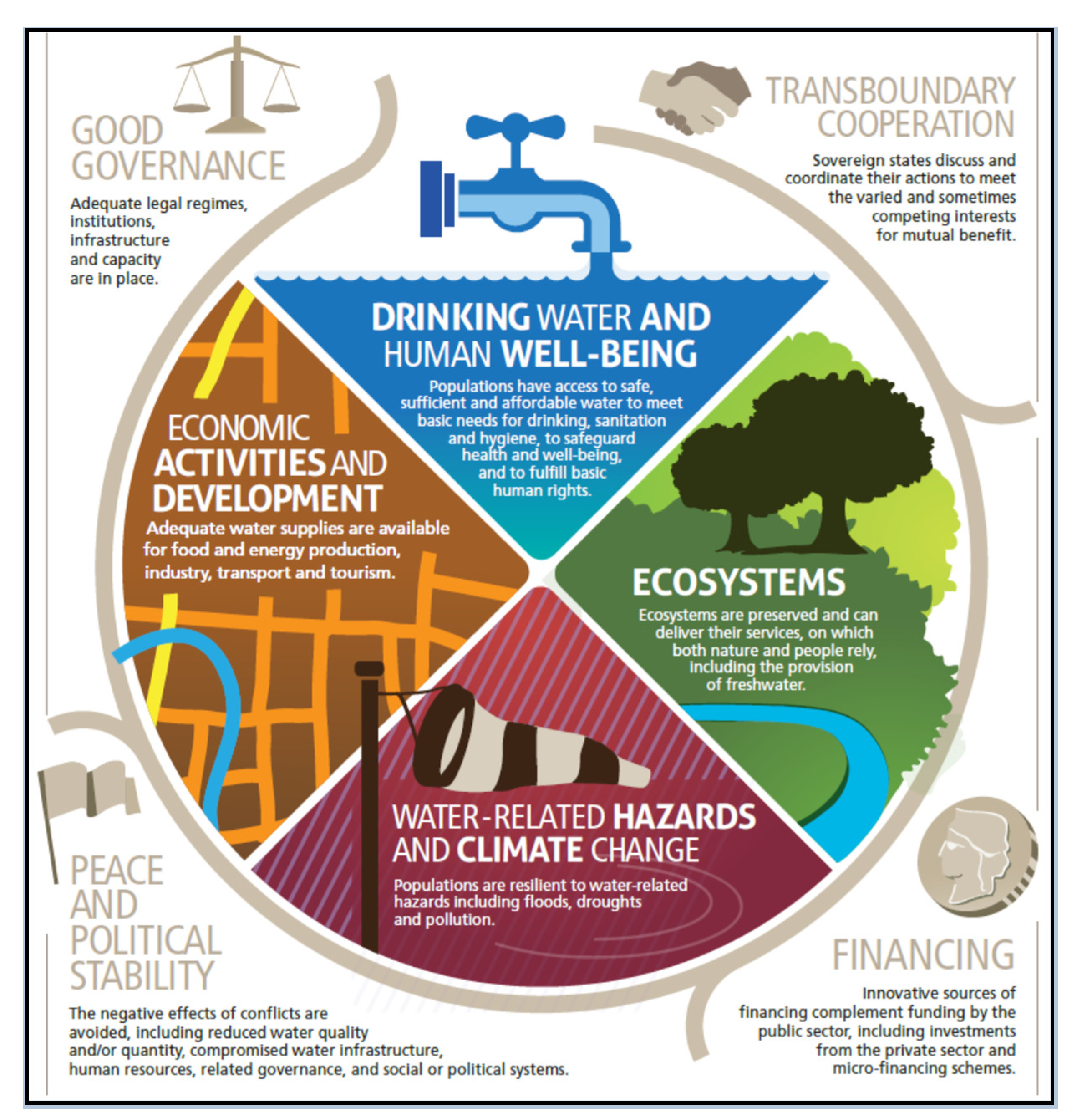
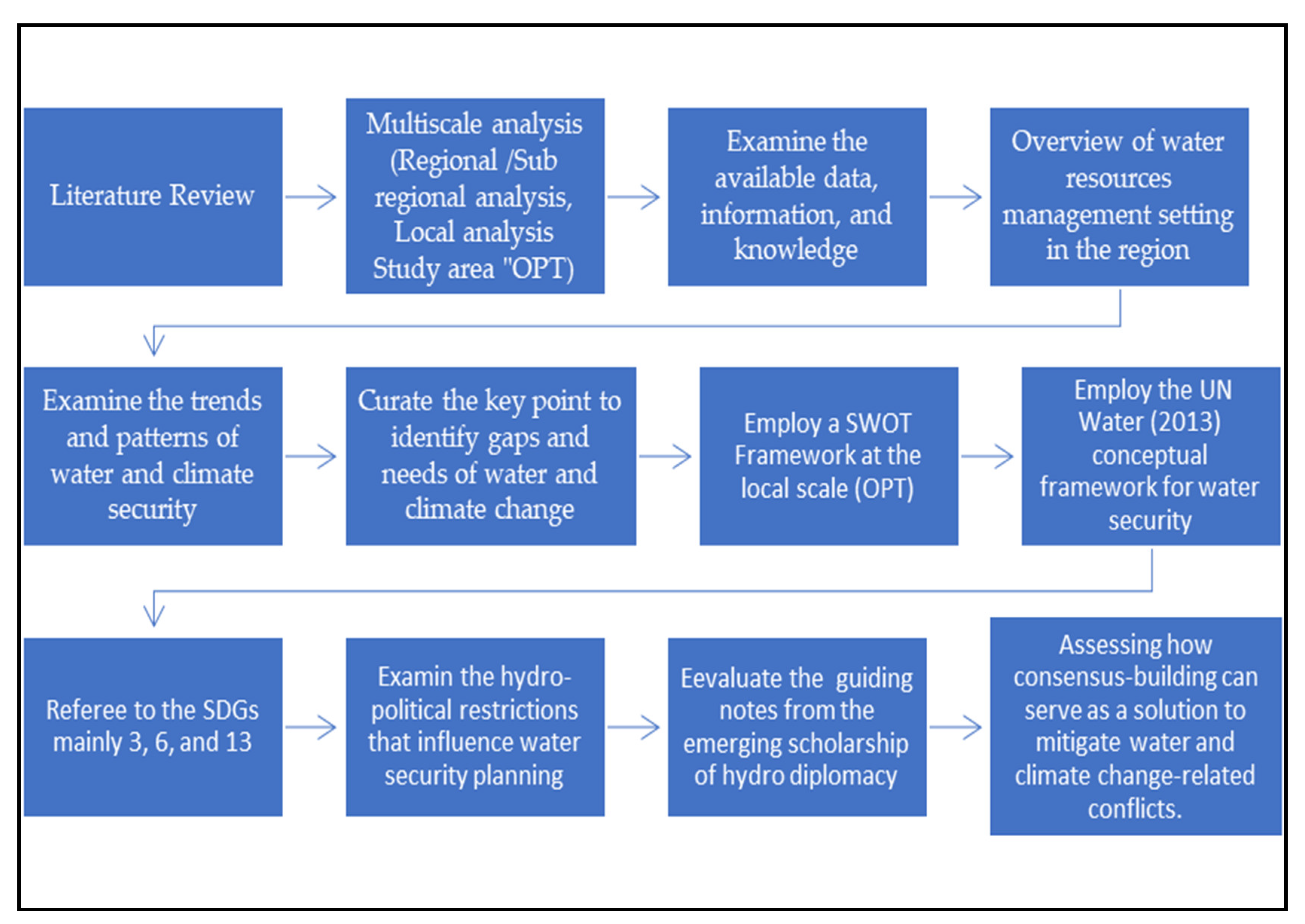
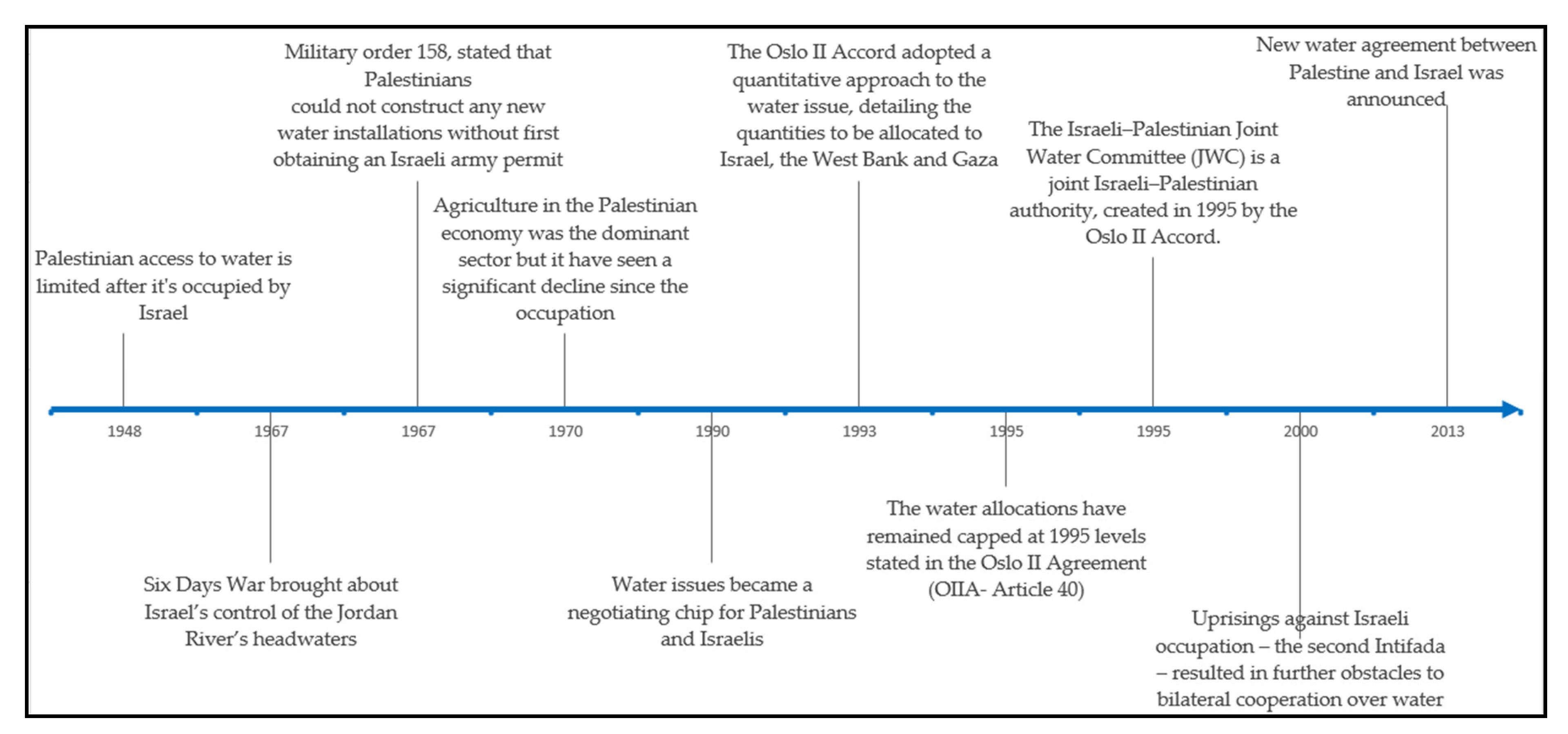
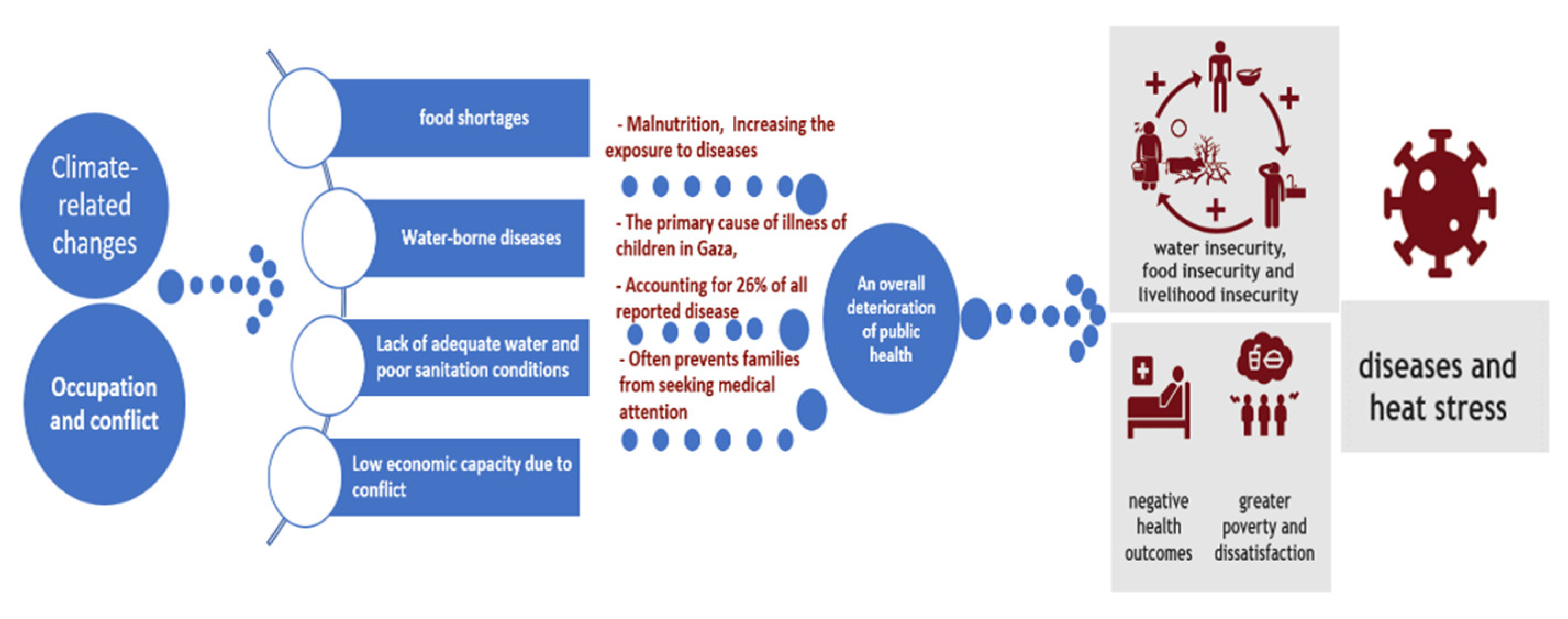
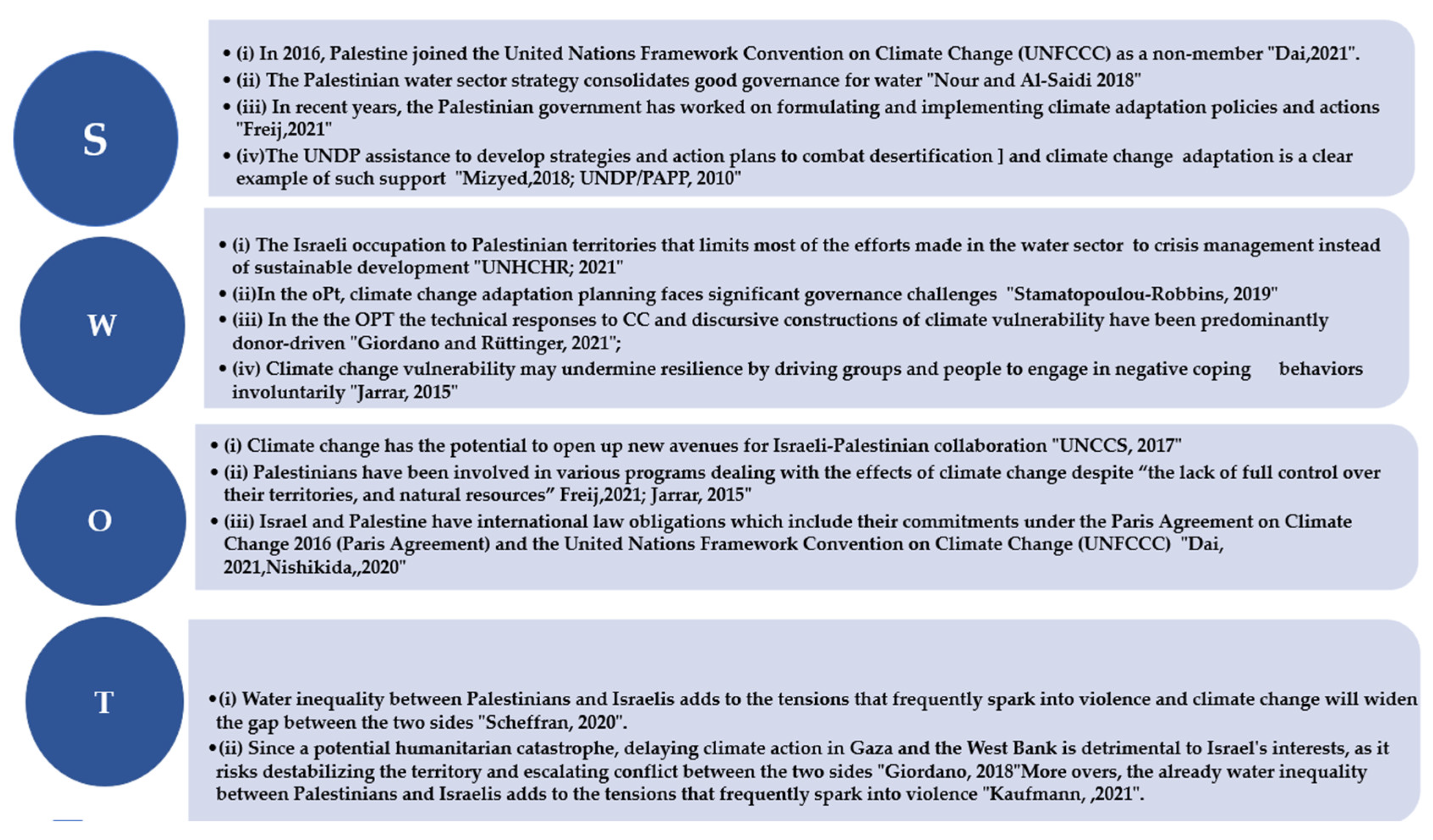
| # | UN Water (2013) Water Security Conceptual Framework Dimensions | Assessment for the MENA Region |
|---|---|---|
| 1 | Ecosystem, Climate Change, and Human Well Being | - Summer temperatures may increase by 8 °C, water runoff by 75%, and land aridity by 60% [34] - In the summer, heat waves affect >80% of local communities [36]. |
| - About 60 million people lack access to clean water, and over 70 million lack proper sanitation [27]. - Climate change has caused severe water shortages (less than 500 m3/an/habitant) in Yemen, Jordan, Libya, and Algeria [21]. | ||
| 3 | Transboundary Cooperation | - Power imbalance prevents the Jordan River Basin from fairly and evenly sharing water [37]. - The power relations in the Joint Water Committee (JWC). The Oslo II Agreement set up the JWC, in which each party has equal representation and veto power, to implement the undertakings under Article 40. According to the agreement, the JWC functions on the basis of consensus; both Israelis and Palestinians must give their approval for any project involving water abstraction from the Mountain Aquifer. Things are not equal where the Israeli representatives have delayed a large proportion of Palestinian applications in the JWC, and the approval rates for Palestinian applications are significantly lower than for Israeli applications [24]. - The Euphrates is Syria’s major water supply, whereas the Tigris is Iraq’s. Both are worried about Turkish control of their important rivers [32]. |
| 4 | Peace and Political Stability | - Around 700 natural catastrophes and 80 inter-state armed conflicts in 18 Mediterranean nations have been noted since 1945 [32]. - The Uppsala Conflict Data Programme revealed that natural disasters were likely to precede 50% of conflict outbreaks [33]. - The Nile, Euphrates, Tigris, and Jordan rivers have all seen and reported water resource conflicts [38]. - In the MENA region, political elites have tackled water shortages by building massive dams, desalination, cross-basin water transfers, tapping into groundwater aquifers, and importing virtual water through food imports [31]. |
| 5 | Financing | - States in the MENA region have unique political and economic settings [32] - In countries (particularly those in Arabian Peninsula) where natural resources are scarce, inequality is rampant; while some are prosperous economically, others greatly suffer [39] - Water and electricity are scarce and expensive in MENA, compared to other regions [3]. - The World Bank is presently investing $1.5 billion in the MENA region to combat climate change [31]. |
| # | Key Criteria | Occupied Palestinian Territories (West Bank and Gaza Strip) | |
|---|---|---|---|
| West Bank, Including East Jerusalem | Gaza Strip | ||
| Water availability | - Nearly 660,000 Palestinians in the West Bank lack access to water. - 420,000 people drinking less than 50 L each day (WHO is below the 100 L recommended) - In Area C, where Israel has full military control, some communities survive on as low as 20 l/c/d. - About 14,000 Palestinians in 180 localities in Area C lack access to water and are in danger of water scarcity. As of 2014, Israelis consumed 87% of the mountain aquifer waters and just 13% of Palestinians due to Israel’s restrictions. - >80% of the West Bank’s annual water supply (91 MCM) comes from Mekorot, most of it from the West Bank’s Mountain aquifer. - Only 6.8% of the West Bank’s farmed area is irrigated due to a lack of water. - Industrial and agricultural sectors are exploiting water resources that should be accessible to people and communities. | - On average, half of the population—or one million people—need water and sanitation interventions. - Gaza’s sustainable renewable resources total 90 L per capita per day, yet half is used for agriculture. - Gaza has a chronic electrical shortage, affecting basic services including health, water, and sanitation. - War damages in the WASH sector resulted from the 2014 war. This needs to be revised, because our estimation of the damage reports resulting from this war is around USD35 million (reference, PWA/CMWU damage assessment report). - The Gaza Strip has been under a blockade since 2006, preventing the reconstruction or growth of water-related infrastructure. - The absence of water and sanitation facilities in Gaza has driven people to buy water from private sellers in unsanitary circumstances, putting their health in danger. - An estimated 97% of the population consumes water from unregulated private water tankers and small-scale informal desalination facilities. | |
| Water Quality | - Many Jordan Valley wells have chloride concentrations exceeding the WHO standard (250 mg/L). - Waste from Palestinian cities and villages as well as Israeli settlements pollutes freshwater streams and groundwater. - Wadi al-Nar (Kidron Valley) in southeast Jerusalem is one of the West Bank’s most contaminated areas, absorbing about 13 MCM of sewage annually from Jerusalem and Palestinian towns. - Israel sends sewage sludge, infected medical waste, used oils, solvents, metals, electronics, and batteries to the West Bank waste treatment facilities. | - In Gaza, 96% of families get water that does not meet the criteria for drinking water. - Water scarcity in Gaza has led to over-extraction of the coastal aquifer, resulting in increased seawater intrusion. - Ongoing conflicts and energy shortages have hampered the operation of roughly 500 vital local water and sanitation facilities, leading to persistent pollution of the coastal aquifer and the surrounding ecosystem. - Water quality is also degraded owing to Israel’s delivery mechanism. The Oslo Accords require Israel to give Gaza five MCM annually (The Palestinian Authority purchases water from Mekorot, which streams it through the existing network, where it is then mixed with groundwater, resulting in water that is not fit for human consumption. Although it cannot be used for drinking or cooking, this water is reportedly used for other purposes. In 2019, several reports indicated that work was underway to establish a fourth pipeline that would help double the amount of water supplied by Israel to Gaza [47]). - Intensive use of agricultural pesticides and sewage into the aquifer has resulted in just 12.4% of Gaza wells fulfilling WHO nitrate requirements and 19.3% meeting WHO chloride standards (the State of Environment and Outlook Report for The Occupied Palestinian Territory 2020 [84]. Available online: https://wedocs.unep.org/20.500.11822/32268 accessed on 7 February 2022). | |
| Water Accessibility | - As Israeli settlements expand over the West Bank, including East Jerusalem, land and property have been confiscated, as have natural resources such as water. - Palestinians in East Jerusalem have unique challenges in getting water because of several water systems. - Destroying and confiscating 158 structures in November 2020 (including mobile water tanks, plastic water tanks, and hygiene facilities) and forcing evictions in the Bedouin community of Huma Al-Baqai’a in the northern Jordan Valley of the occupied West Bank resulted in the displacement of 70 people, including 35 children. | - Despite Israel’s access to alternative water resources, United Nations Special Procedures mandate holders have highlighted that Israel contributes to the inaccessibility of water in Gaza by using 75 percent of the sustainable groundwater amount each year from the coastal aquifer, leaving little of it available for Gaza. - “Israel has diverted the Stormwater flow from the Jabal Al Khalil mountains towards Wadi Gaza in southern West Bank, which has previously replenished Gaza groundwater”. - Gaza’s dense population makes accessing water and sanitation facilities difficult. | |
| Water Affordability | - Scarcity of safe drinking water in the West Bank, including East Jerusalem, has led Palestinians to purchase water at extremely high prices through official providers and to a lesser extent from private entities. - Cost of purchased water can be six times higher than the national price (USD1.5) per cubic meter in Area C. (The Oslo Accords including the Oslo Interim Agreement (Oslo II signed in 1995), also divided the West Bank into Area A (where the Palestinian Authority would manage full security and civil affairs), Area B (where the Palestinian Authority would manage civil affairs and Israel security control), and Area C (where Israel would have exclusive control). In Areas A and B, Palestinian institutions manage civilian governance, including those relevant to the environment. The Palestinian Authority has no access to Area C (60 percent of the West Bank), which contains the majority of the agricultural lands, water sources, and underground reservoirs of the Occupied Palestinian Territory) [47]. - Water costs 15% of household expenditures in Area C. - Approximately 10% of Palestinians in the West Bank buy water from tankers, paying up to 400% more per liter than areas connected to the network. - Water acquired from private tankers may be of varied quality and expensive since it is not regulated by any official body. | - In Gaza, 64% of the population lives in poverty and drinking water has become costly. - Around 20,200 households cannot afford safe drinking water and depend on public filling stations or poor tap water, putting their children at risk of water-borne illnesses - Affordable water costs should not exceed 3% of family income; however, research shows households in Gaza spend up to a third or even half of their income on water. | |
Publisher’s Note: MDPI stays neutral with regard to jurisdictional claims in published maps and institutional affiliations. |
© 2022 by the authors. Licensee MDPI, Basel, Switzerland. This article is an open access article distributed under the terms and conditions of the Creative Commons Attribution (CC BY) license (https://creativecommons.org/licenses/by/4.0/).
Share and Cite
Sarsour, A.; Nagabhatla, N. Options and Strategies for Planning Water and Climate Security in the Occupied Palestinian Territories. Water 2022, 14, 3418. https://doi.org/10.3390/w14213418
Sarsour A, Nagabhatla N. Options and Strategies for Planning Water and Climate Security in the Occupied Palestinian Territories. Water. 2022; 14(21):3418. https://doi.org/10.3390/w14213418
Chicago/Turabian StyleSarsour, Amal, and Nidhi Nagabhatla. 2022. "Options and Strategies for Planning Water and Climate Security in the Occupied Palestinian Territories" Water 14, no. 21: 3418. https://doi.org/10.3390/w14213418
APA StyleSarsour, A., & Nagabhatla, N. (2022). Options and Strategies for Planning Water and Climate Security in the Occupied Palestinian Territories. Water, 14(21), 3418. https://doi.org/10.3390/w14213418






